How to Cool Down a Wood Stove Quickly 2025
- October 4, 2023
- 1 comment
Learn how to cool down a wood stove quickly in 2025 with expert tips. Safely reduce heat and enhance efficiency with proven techniques. When you’ve got a wood stove roaring with heat, there might be occasions when you need to cool it down more swiftly than usual. Maybe you’re leaving the house, or perhaps the room has become uncomfortably hot. Whatever the reason, safety is paramount. Here are some tried-and-true methods and tips to cool down your wood stove efficiently and safely.
List How to Cool Down a Wood Stove Quickly:
- Stop Adding Fuel
- Spread Out the Coals
- Close the Air Intake
- Use a Stove Fan
- Open Windows or Doors
- Heat-Resistant Ceramic Tiles
- Water Spritzing
“Nature teaches us balance: For every sun, there’s shade; for every blazing log, a moment to cool and reflect.” — Nathan Timberland
1. Stop Adding Fuel
To cool down your wood stove effectively, stop adding fuel. Continuously feeding wood keeps the fire burning at a high temperature. If your goal is to reduce the stove’s heat, it’s essential to cease adding any new combustibles. This allows the existing wood to burn through its natural combustion cycle which includes ignition, sustained burning, and a smoldering phase that generates less heat.
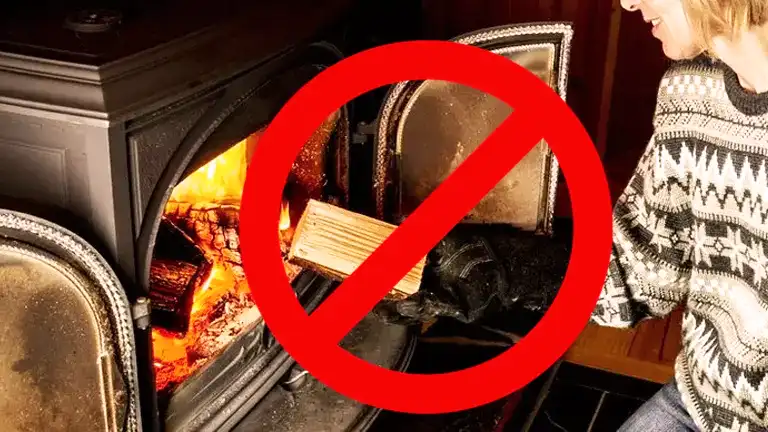
Moreover, halting the addition of wood helps manage the oxygen consumption inside the stove. As wood nears the end of its burning cycle, it requires less oxygen, leading to a slower, less intense burn which contributes to the cooling process. Additionally, adding fresh wood can increase embers and sparks that hold heat longer. By avoiding new additions, you minimize ember production, aiding in the cooling. This method not only helps cool your stove faster but also ensures maximum energy efficiency by allowing wood to fully burn to ash, utilizing its energy potential completely.
2. Spread Out the Coals
Spreading out the coals within your wood stove can significantly help in reducing its temperature. When coals are piled together, they insulate each other, maintaining a high heat concentration. By distributing them across the stove, you increase their exposure to cooler air inside, accelerating heat dissipation. This technique also avoids the creation of hot spots where coals might overheat and produce unnecessary warmth.
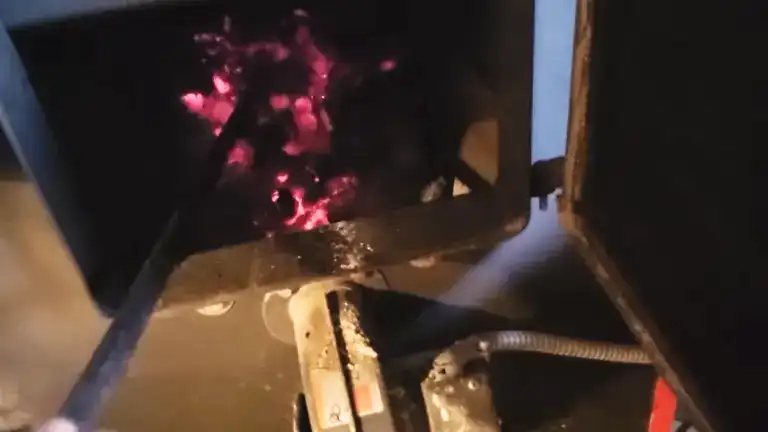
Additionally, dispersing the coals ensures they have better access to oxygen, leading to a more even and less intense burn. This prevents accidental reignition from close contact between logs and coals, which could otherwise keep the stove hotter for longer. For safety and effectiveness, use a stove poker to adjust the coals. This method not only aids in cooling your stove more efficiently but also allows you to monitor the remaining energy of the coals, making it easier to manage the stove’s heat output to your needs.
3. Close the Air Intake
Closing the air intake of your wood stove is an effective method to reduce its temperature. By limiting the amount of oxygen available, which is essential for combustion, you can directly control the intensity of the fire. Reducing oxygen slows down the chemical reactions that fuel the fire, leading to decreased heat and smaller flames. This adjustment is facilitated by built-in controls in modern stoves that allow for precise regulation of air flow, supporting either enhancement of the fire or its reduction.

However, while closing the air intake can efficiently cool down the stove, it does have its cautions. Restricted airflow can increase the production of carbon monoxide, a dangerous gas that is both colorless and odorless. To ensure safety, it’s crucial to maintain adequate ventilation in the area and to keep a carbon monoxide detector operational. By managing the air intake carefully, you can achieve a cooler stove while minimizing risks, ensuring a safe and comfortable environment.
4. Use a Stove Fan
Stove fans are ingenious devices that improve the efficiency of wood stoves by distributing heat more evenly throughout the room. These fans typically operate on thermoelectric power, where heat from the stove generates electricity through the temperature difference between a hot base and a cooler top fin. This energy powers the fan without the need for external electricity. As the stove heats up, the fan’s speed increases, which helps to circulate warm air that would otherwise rise and accumulate at the ceiling, ensuring the room’s temperature is more uniformly comfortable.
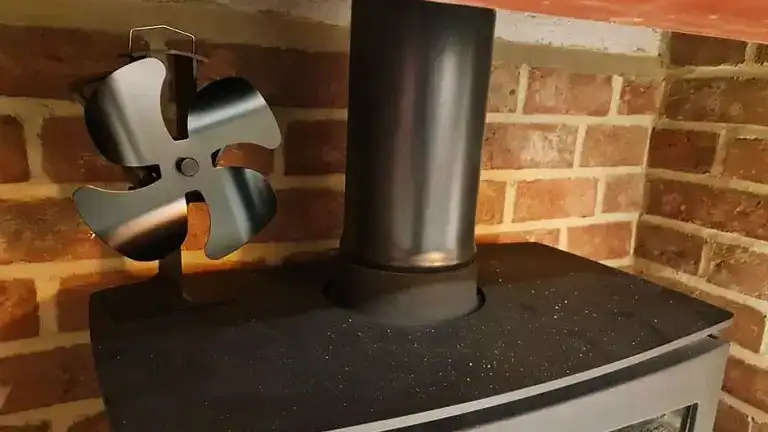
Deploying a stove fan also aids in cooling your stove more efficiently. By moving the hot air away from the stove and throughout the room, it reduces the temperature around the stove and eliminates hot spots. This helps the stove and the room lose heat faster. To optimize a stove fan’s performance, place it at the back of the stove, away from excessive direct heat like the flue pipe to avoid damage. Regular maintenance, such as cleaning and checking for wear, ensures the fan operates safely and effectively, making it a cost-effective and environmentally friendly addition to wood stove setups.
Hey there! If you’re on the hunt for a wood stove fan for your cozy space, take a peek at our article. We think you’ll find it super helpful! 5 Best Wood Stove Fans on Amazon 2023
5. Open Windows or Doors
Opening windows or doors is a straightforward yet effective method for cooling a room heated by a wood stove. As hot air rises and accumulates, it creates a high-pressure area indoors. Opening a window or door allows this hot air to escape to the cooler, lower-pressure outdoors, naturally lowering the room’s temperature. The exit of hot air is then compensated by an influx of cooler outdoor air, which helps in rapidly reducing both the room’s and the stove’s temperature. This exchange is especially effective if you set up cross-ventilation by opening multiple windows or doors across the room or house, promoting a thorough air sweep.
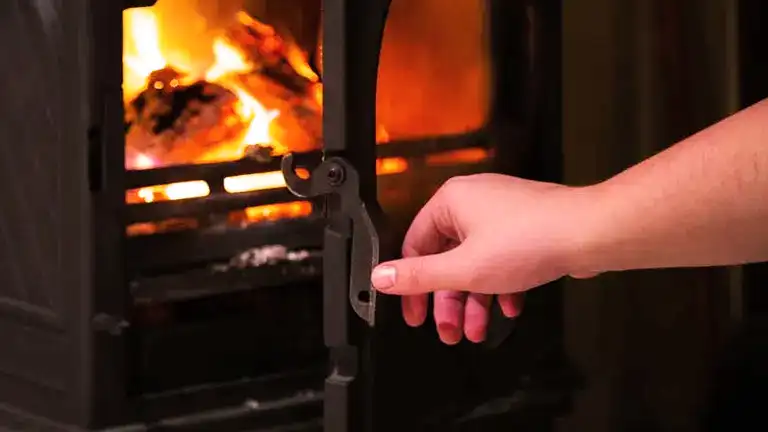
However, it’s important to consider the external environment when using this method. Strong winds can increase the intensity of the fire by providing more oxygen through drafts, which is counterproductive if your goal is to cool the stove. Also, open windows may invite rain or debris, complicating indoor conditions. On chilly days, excessive ventilation could lead to unwanted heat loss, impacting energy efficiency. To avoid these pitfalls, adjust the extent of openings based on the weather and your specific needs to maintain a balance between effective cooling and maintaining a comfortable, efficient home environment.
6. Heat-Resistant Ceramic Tiles
Heat-resistant ceramic tiles are an excellent choice for homes with wood stoves due to their ability to absorb and dissipate heat effectively. These tiles draw in a large amount of the heat radiated by the stove, which prevents it from spreading too quickly into the surrounding space. This capability not only makes the heating system more efficient by storing the heat but also safer, as it controls the temperature rise in nearby materials that could be sensitive to high heat. Over time, the tiles gradually release the absorbed heat back into the room, maintaining a comfortable temperature long after the fire in the stove has diminished.
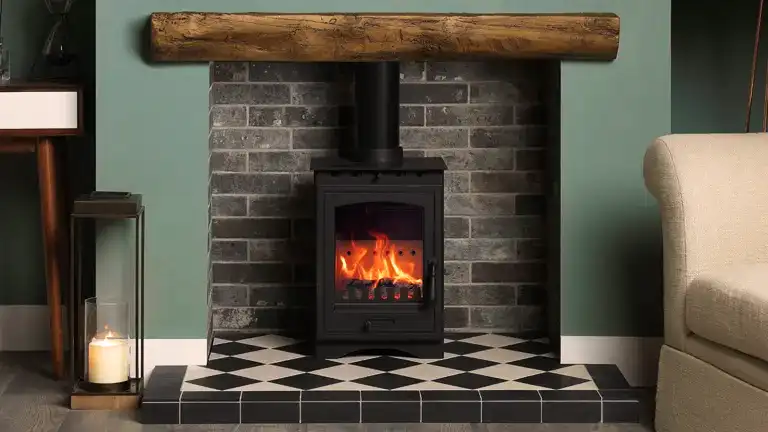
In addition to their practical benefits, ceramic tiles also contribute aesthetically to the room. They are available in a variety of designs, colors, and finishes, allowing homeowners to match them with the interior décor. This makes the stove area not just a source of warmth but also a visual highlight of the space. For proper installation, it’s important to use heat-resistant adhesives and allow for slight gaps between the tiles to accommodate thermal expansion. With minimal maintenance, these tiles can provide durable, long-lasting heat management and decoration, enhancing both the function and the style of the room where the wood stove is located.
7. Water Spritzing
Water spritzing can effectively cool down a wood stove by utilizing the heat-absorbing properties of water. When sprayed into a stove, water quickly evaporates, absorbing significant heat in the process and thereby lowering the stove’s internal temperature. This method is especially useful when you need to quickly reduce the stove’s heat output. However, it’s crucial to understand the science and the delicate balance required to avoid hazards.
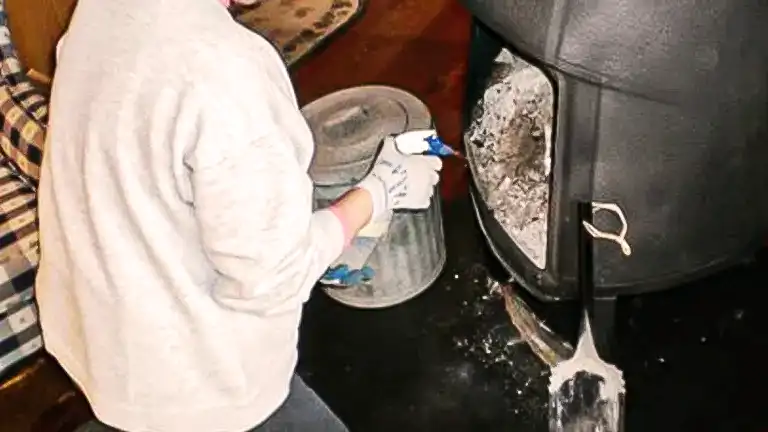
Despite its effectiveness, water spritzing carries risks. Rapid introduction of water can produce excessive steam, increasing pressure inside the stove that could lead to a steam explosion. The sudden temperature drop may also cause the metal components of the stove to contract swiftly, potentially leading to damage or warping. Repeated thermal stress from frequent cooling might weaken the stove’s materials over time, and any ceramic or glass parts could crack under the strain of rapid temperature changes. To minimize these risks, use a spray bottle that emits a fine mist to gently introduce a small amount of water, ensuring controlled cooling. Always ensure that there is a clear path for steam to escape, like a properly functioning flue or chimney, to manage the pressure and avoid any buildup inside the stove.
Safety Precautions
- Always Wear Gloves: When working with a hot wood stove, always wear heat-resistant gloves. This will protect your hands from burns and allow you to work more confidently.
- Monitor Carbon Monoxide: Ensure that you have a working carbon monoxide detector in the same room as your wood stove. If you’re limiting the air to the stove, there’s an increased risk of carbon monoxide production.
- Don’t Use Water Excessively: Pouring a lot of water on a hot stove or fire can cause steam explosions or even crack the stove. Use the water spritzing method sparingly.
- Keep Children and Pets Away: When trying to cool down your wood stove, ensure that children and pets are kept at a safe distance. They might be unaware of the heat and risks associated with a hot stove.
Conclusion
Cooling down a wood stove quickly requires a combination of methods and safety precautions. By understanding the mechanics of your stove and the principles of combustion, you can manage the heat output effectively. Always prioritize safety and never rush the process. With patience and care, you can ensure that your wood stove is a warm, comforting, and safe addition to your home.
Related Articles:
- How To Deal With Backdraft Issues in Wood Stoves and Fireplaces
- How to Move a Wood Stove Safely and Securely
- How to Ensure Proper Ventilation and Airflow for Your Wood Stove
- How to Get Wood Stove Heat to Other Rooms: A Comprehensive Guide
- How to Choose the Best Wood Stove Pipe
- How To Clean Your Chimney
- How to Install a Wood Stove in the Basement 2023
FAQs
- Is it harmful to the wood stove if it’s cooled down rapidly?
While most wood stoves are built to handle varying temperatures, rapid cooling (such as pouring a large amount of water) can cause the metal to contract quickly, potentially damaging or warping it. Always opt for gradual cooling methods. - Can I use any kind of fan to help cool down the stove?
While regular fans can distribute room air, stove fans are specifically designed to operate at higher temperatures near stoves. They’re more effective and safer in this environment. - Why shouldn’t I just throw cold water onto the stove to cool it down?
Rapid cooling using cold water can lead to metal warping, cracking of the stove, or even steam explosions. It’s a dangerous method and is not recommended. - I’ve spread out the coals, but the stove remains hot. What’s happening?
Spreading the coals reduces the fire’s intensity, but the stove retains heat in its material. It will cool down gradually as it releases stored heat. - How do heat-resistant ceramic tiles help in cooling the stove?
These tiles absorb and store heat, releasing it slowly over time. By drawing away and dispersing heat, they can reduce the immediate temperature around the stove. - If I’m using the water spritzing method, won’t the steam increase room humidity?
Yes, it can. However, the amount of steam from light spritzing is minimal. If you use this method frequently or excessively, it might raise the room’s humidity levels. - Can I use ashes to help cool down the stove?
Partially. Spreading a layer of ash over the coals can insulate and reduce their oxygen supply, making them burn out faster. However, always ensure proper ash disposal afterward. - Why does closing the air intake help in cooling the stove?
Fire requires oxygen to burn. By limiting the oxygen supply via the air intake, you’re essentially starving the fire, which makes it burn slower and cooler. - Is it safe to sleep with the stove still warm?
It’s generally safe to sleep with a warm stove, as long as the fire is under control and there’s no risk of embers or sparks escaping. Ensure there’s a carbon monoxide detector in the room and it’s working correctly.
Thanks for checking out our guide on How to Cool Down a Wood Stove Quickly 2023! We hope you found it helpful and insightful. Your thoughts and experiences matter a lot to us and our community—feel free to drop any tips or stories you have about cooling wood stoves in the comments. Let’s keep learning from each other and ensure everyone stays safe and cozy!

David Murray
Forestry AuthorI'm David Murry, a forestry equipment specialist with a focus on chainsaw operation. With over 13 years of experience, I've honed my skills in operating and maintaining a wide range of machinery, from chainsaws to log splitters. My passion for the outdoors and commitment to sustainable forestry drive my work, which emphasizes safety, efficiency, and staying updated with industry advancements. Additionally, I'm dedicated to sharing my expertise and promoting environmental awareness within the forestry community.













Most of your "ideas" would immediately increase the heat coming from the wood stove. Starving the burn of oxygen is the only real solution.
David Goodrow
October 5, 2023 11:11 pm